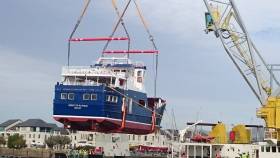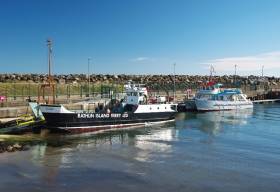Displaying items by tag: New Rathlin Island car ferry
Rare Launch in Irish Shipbuilding of Car Ferry at Arklow for Rathlin Island
#FerryLaunched – A newbuild and that of a car ferry, which is rare in Irish shipbuilding, was launched at Arklow, Co. Wicklow yesterday, writes Jehan Ashmore.
The 6 vehicle / 140 passenger ferry, Spirit of Rathlin was launched from Arklow Marine Services, which involved the Belfast registered newbuild hoisted off the quayside by a floating crane, Lara 1 and lowered into the River Avoca. The self-propelled crane barge was chartered to the the port for the operation and is more commonly known as the former Mersey Docks & Harbour Board's Mersey Mammoth.
Spectators lined the banks opposite North Quay, to witness the proud moment for the boatyard which was awarded the contract by Northern Ireland’s Department for Infrastructure (DFI). The DFI is still in the process of evaluating the bids for tenderers as previously reported to operate the new Rathlin ferry between the island off Co. Antrim and Ballycastle.
Arklow Marine which is owned by the Tyrrell family, now in their fifth generation of running the marine engineering business synominous with Irish shipbuilding that can trace its origins to 1864. Among the most famous of vessels launched was the State's first custom built sail-training ship, the brigantine, Asgard II built in 1981.
Asides car ferry building, the yard have also designed and constructed vessels including aluminium catamarans, amphibious vessels, trawlers, tugs, and workboats. They also carry out conversion, repair and refit work.
In more recent years AMS has branched out into specialist newbuilds for the offshore energy sector, with the completion of Wind Farm Service support vessels for the UK market.
Arklow Marine to Launch New Car Ferry for Rathlin Island Route
#NewBuild - Arklow Marine Services are to launch a new car ferry which is to serve Rathlin Island off the Antrim coast, writes Jehan Ashmore.
Northern Ireland’s Department for Infrastructure (DFI) awarded the contract for the 6 vehicle /140 passenger ferry to the Co. Wicklow based boatbuilder, headed by Billy and John Tyrell.
Responding to Afloat.ie a DFI spokesperson said the Department is still in the process of evaluating the bids for tenderers to operate the new Rathlin ferry.
Following delivery of the new ferry to be named Spirit of Rathlin, the newbuild is to undertake trials for three to four weeks. In addition crew familiarisation is to take place, after which the vessel is expected to come into operation.
The Ballycastle-Rathlin route is operated by the Rathlin Island Ferry Ltd which currently uses three vessels, Canna, Rathlin Express and St. Sorney.
Canna is an ageing ‘Island’ class car ferry, which dates to 1976, having originally served the Scottish West Isles for CalMac. The 40 year-old ferry bow-loading vessel has the same vehicle and passenger capacity of the newbuild.
In 1997, Canna was transferred to Rathlin with CalMac contracted to run the service. In the following year she was chartered by the Scottish publically funded ferry company to Rathlin Island Ferry Ltd who took over the operation of the service.
In 2009 the passenger-only, Rathlin Express, an aluminium catamaran craft, also built by Arklow Marine Services entered the route.
This leaves the third vessel, St. Sorney, also passenger-only and which serves as a reserve boat. The 40ft ‘Lochin’ cruiser was built by Ryan & Roberts of Limerick.

























































